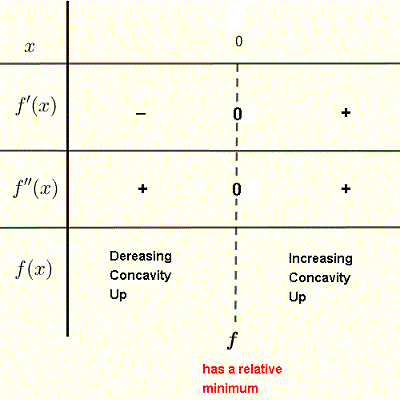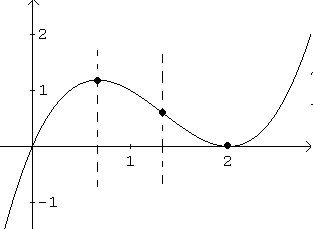Example 1
Use first and second derivative theorems to graph function \( f \) defined bySolution to Example 1.
step 1: Find the first derivative, any stationary points and the sign of \( f' (x) \) to find intervals where \( f \) increases or decreases.
\( f' (x) = 2x \)
The stationary points are solutions to:
The sign of \( f' (x) \) is given in the table below.
\( f' (x) \) is negative on \((-∞ , 0)\) and therefore \( f \) decreases on this interval according to theorem 4 above.
\( f' (x) \) is positive on \((0 , ∞)\) \( f \) and therefore increases on this interval according to theorem 4 above.
Also according to theorem 2(part a) "using first and second derivatives", \( f \) has a minimum at \( x = 0 \).

step 2: Find the second derivative, its signs and any information about concavity.
\( f ''(x) = 2 \) and is always positive (this confirms the fact that \( f \) has a minimum value at \( x = 0 \) since \( f ''(0) = 2 \), the graph of \( f \) will be concave up on \((-∞ , +∞)\) according to theorem 5(part a) above.
step 3: Find any \( x \) and \( y \) intercepts and extrema.
\( y \) intercept = \( f(0) = 0 \).
\( x \) intercepts are found by solving \( f(x) = x^2 = 0 \). \( x \) intercept = 0.
From the signs of \( f' \) and \( f'' \), there is a minimum at \( x = 0 \) which gives the minimum point at \( (0 , 0) \).
step 4: Put all information in a table and graph \( f \).
Also as \( x \) becomes very large (+∞) or very small (-∞), \( f(x) = x^2 \) becomes very large.
See table above and graph below.

Example 2
Use first and second derivative theorems to graph function \( f \) defined bySolution to Example 2.
step 1: \( f ' (x) = 3x^2 - 8x + 4 \).
Solve: \( 3x^2 - 8x + 4 = 0 \)
solutions are: \( x = 2 \) and \( x = \frac{2}{3} \).
See table of sign below that also shows interval of increase/decrease and maximum and minimum points.
step 2: \( f '' (x) = 6x - 8 \).
Solve \( 6x - 8 = 0 \) ; solution is \( x = \frac{4}{3} \) inflection point where concavity changes. See sign and concavity in table below.
step 3: \( y \) intercept = \( f(0) = 0 \). \( x \) intercepts solve \( x^3 - 4x^2 + 4x = 0 \).
factor \( x \) out \( x(x^2 - 4x + 4) = 0 \) and solve the quadratic equation \( x^2 - 4x + 4 = (x - 2)^2 = 0 \) to find solutions: \( x = 0, x = 2 \) of multiplicity 2.
Also as \( x \) becomes very large (+∞) , \( f(x) = x^3 - 4x^2 + 4x \) becomes very large (+∞). As \( x \) becomes very small (-∞), \( f(x) \) becomes very small (-∞).
step 4: The table and the graph are shown below.

